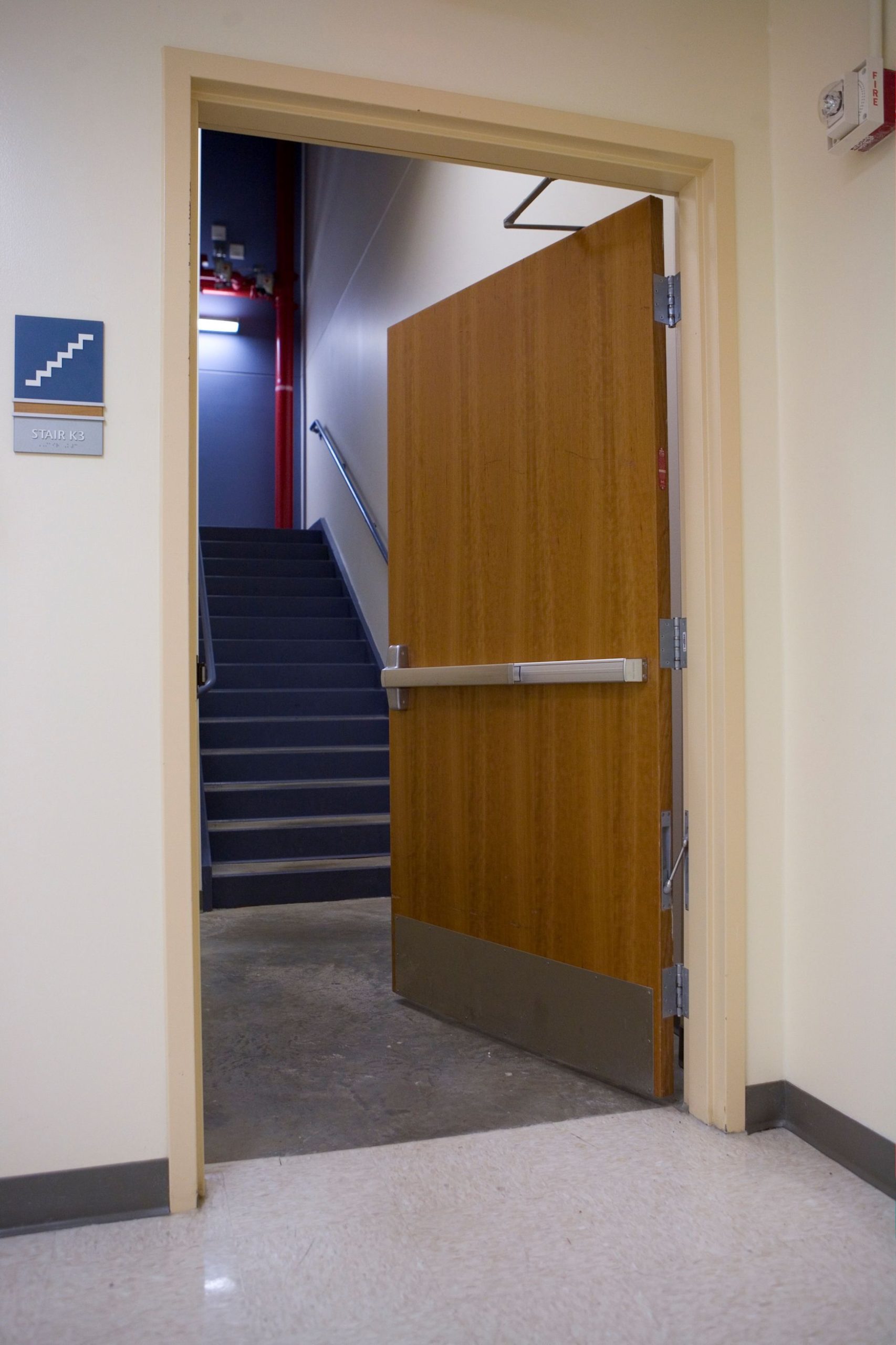 Fire doors in health care facilities are getting a lot more attention these days, because of the adoption of codes and standards that require fire door assembly inspections. Facilities that receive funding from the Centers for Medicare and Medicaid Services (CMS) are surveyed periodically by the Joint Commission or another accrediting organization. Since 2016, these Authorities Having Jurisdiction (AHJs) have used the 2012 edition of NFPA 101 – Life Safety Code to assess life safety features, including egress doors and fire doors. This edition of the code requires fire doors to be inspected annually, in accordance with NFPA 80 – Standard for Fire Doors and Other Opening Protectives.
Fire doors in health care facilities are getting a lot more attention these days, because of the adoption of codes and standards that require fire door assembly inspections. Facilities that receive funding from the Centers for Medicare and Medicaid Services (CMS) are surveyed periodically by the Joint Commission or another accrediting organization. Since 2016, these Authorities Having Jurisdiction (AHJs) have used the 2012 edition of NFPA 101 – Life Safety Code to assess life safety features, including egress doors and fire doors. This edition of the code requires fire doors to be inspected annually, in accordance with NFPA 80 – Standard for Fire Doors and Other Opening Protectives.
Fire door inspections are taking place in other types of facilities too – I have been fielding quite a few calls and emails lately. One government agency responsible for thousands of buildings across the US wanted to discuss their new standards, which will cover inspection of fire door assemblies. Several fire marshals and other code officials have asked about the availability of resources to give their inspectors an overview of the inspection criteria. And many people have asked where to find training to become a fire door inspector, to meet the needs of their customers. This interest and enforcement have been a long time coming – it has been 14 years since the inspection requirements were added to the 2007 edition of NFPA 80.
As I talk to people about this topic, two sides of the discussion have begun to emerge. Many understand the increased life safety and fire protection that will be provided by fire door assemblies that have been inspected and deemed compliant with the standard. One fire marshal told me how excited he was that his state was adopting an edition of the International Fire Code that required fire door assemblies to be inspected annually. According to him, it was another tool in his toolbox – he could ask for documentation of the fire door inspections for buildings in his jurisdiction, in addition to the documentation for the sprinkler systems, elevators, fire extinguishers, etc.
The other perspective often comes from those responsible for bringing fire doors with deficiencies back into compliance; these repairs must be made “without delay” (for some AHJs, this is 60 days). Although most acknowledge that code-compliance is important, it can seem like a never-ending project, often with limited resources in the budget. According to data published by the Fire Door Inspection Scheme (FDIS), 76 percent of the fire door assemblies inspected in the UK in 2019 failed the inspection. While I don’t have official numbers for US fire doors, I wouldn’t be surprised if the failure rate was similar. I’ve seen some exasperated facility managers throw up their hands in defeat when faced with the seemingly insurmountable task of solving their fire door problems.
There’s no doubt that finding so many fire door assemblies in need of repair or replacement can be overwhelming. But avoiding the inspection does not solve the problem, as building owners and property managers are responsible for keeping fire doors code-compliant, with or without an inspection. Some deficiencies can be addressed easily, but some are very difficult to rectify. One common example of this is clearance at the perimeter of the door, and at the meeting stiles of pairs. While some products have been developed that can be used to overcome the problem of excessive clearance, more options are needed in order to solve these problems in the field.
It might be tempting to dismiss the NFPA 80 limitations as too restrictive – especially with regard to perimeter clearance, since incorrect clearances are so common and so difficult to bring into compliance. But necessity drives innovation, and I know we will see more solutions hitting the market (let me know if you have others to add to this list). I can say from first-hand experience that excessive clearance can cause a fire door assembly to fail a fire test, however, testing is being done to determine whether clearances can be increased without negatively impacting the performance of the opening protective.
The bottom line here is that fire door assemblies in existing buildings have been neglected for decades and repairing the deficiencies will take a lot of work and a lot of patience. With that said, these opening protectives are a critical part of the passive fire protection system of a building, and they need to be code-compliant to ensure that they will perform as designed and tested if a fire occurs. Fire door assembly inspections – after installation, after maintenance work, and annually, are the first step to identifying the problems and resolving them. This focus on fire doors will result in a greater level of life safety for building occupants, by deterring the spread of fire and protecting the means of egress.
NFPA 80’s inspection criteria for fire door assemblies include verification of the following:
- Labels are present and legible.
- No holes or breaks in door or frame.
- Glazing and glass kit / glass beads are intact and securely fastened.
- Door, frame, and hardware are in proper working order.
- No missing or broken parts.
- Door clearances are within allowable limits.
- Door closer / spring hinges are operational and door is self-closing.
- Coordinator ensures that door leaves close in proper sequence (pairs only).
- Door is self-latching in the closed position.
- Opening is not equipped with auxiliary hardware items which interfere with operation.
- No field modifications have been performed that void the label.
- Gasketing and edge seals, where required, are present, continuous, and of the proper type for a fire door.
- Signage on door covers less than 5% of door face and is not attached with mechanical fasteners.
To learn more about fire doors or to order laminated fire door inspection cards, visit iDigHardware.com/firedoor.
For more information on codes and applications that apply to health care facilities, visit iDigHardware.com/healthcare.
You need to login or register to bookmark/favorite this content.





Lori, A large problem in doors with cylindrical hardware is modification of the strikes which voids the label.
I conduct inspections on all openings for new construction and renovations on our campus. 90% of the fire rated openings fail my inspections. Most of these are due to incorrect gaps and missing seals. The biggest issue I have found though is improperly installed frames. Installers do not know how to properly install frames. The keep the shipping bars on. The do not check to make sure frame is square and plumb, they do not use proper spacers to unsure the frame is the correct measurement at top middle and bottom. Then you have the third party inspectors that give incorrect information for correcting gap issues. We have our own Fire Marshall’s office that will look at existing doors and if they find an issue it gets reported to out Maintenance shops. If they can not easily fix the issue our if the fix would violate the code they contact me to replace the opening. I have given training to our building managers for Fire Rated Assemblies showing them what to look for and to report so that we can keep our buildings up to date.